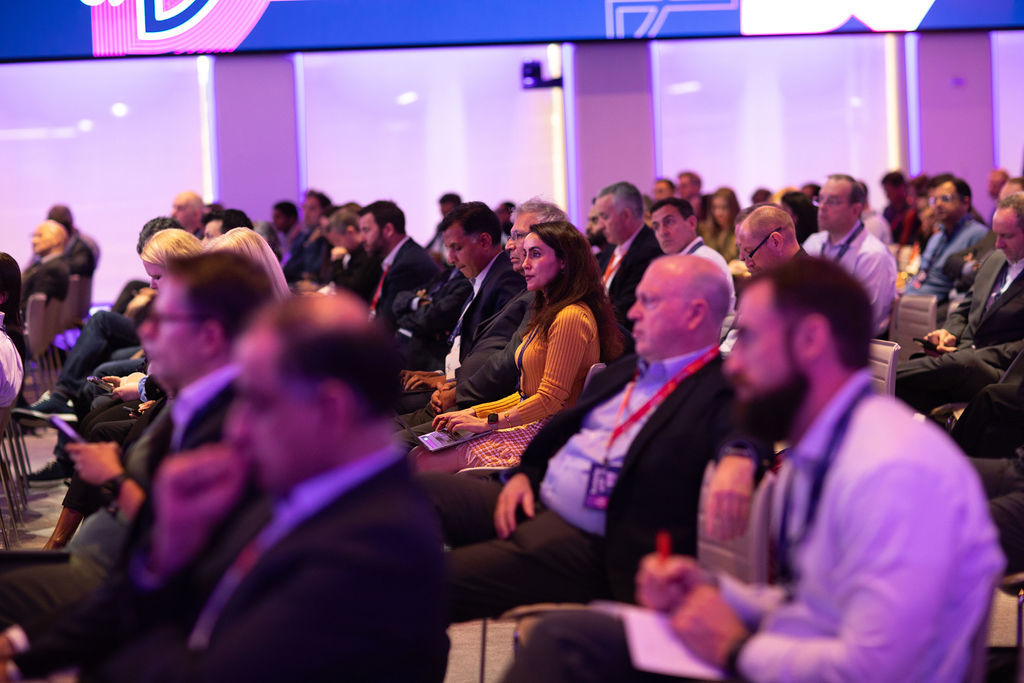In-person conferences are back. If the almost 10,000 people at SaaStr — the outdoor, festival-like conference — were any indication, we are all clamoring to get back together in person.
SaaStr Annual 2022 is a gathering of startups, technology vendors, and investors looking to grow and scale their B2B SaaS businesses. The event had more than 100 sessions, 250 speakers, and 150 vendor booths to engage attendees. Check out the video montage below to get a flavor of the conference.
Insight sent a cross-functional group from its Onsite Centers of Excellence: Marketing, Sales & Customer Success, and Product & Tech. Here are our key takeaways and themes from the conference:
1. In-person events have returned, but SaaStr still stood out
SaaStr required proof of Covid-19 vaccination and a negative test result within 72 hours of arrival. Once attendees cleared those hurdles, very few elected to wear masks. Still, the conference had a unique setup: 90% of the event was outdoors. The keynote stages, breakout sessions, and vendor booths were all under tents and since the weather cooperated, it gave a great feel to the event and allowed attendees to flow from session to session easily. If you’re planning to host an in-person event in the future, learn from this event and:
Decide if the “TikTok” approach to session programming is right for you
At SaaStr, many sessions lasted 10-20 minutes in duration. This quick-hit approach meant that presenters had to create provocative soundbites to generate discussions around water coolers and in line at food trucks. While these TikTok-style approaches could work for a portion of presentations, attendees also benefit from strategic next steps gleaned from an in-depth conversation. For example, when our Insight team presented at Gainsight Pulse, they added a QR code to their presentation to download data-driven thought leadership, such as the Post-Sales Report, allowing for deeper insights, integrated lead capture, and content delivery.
Have a plan to address Covid
SaaStr had a robust plan to address Covid, but as time goes on, this approach can change. If you’re hosting an event—large or small—consider best practices including contactless experiences, on-site health checks, and pre-event testing.
Create content to live well beyond the actual event
Events are a treasure trove of content, and if planned strategically, you could fill most of your annual content calendar with a single event. At a minimum, ensure your main presentations are recorded and consider setting up a time to capture customer interviews for use in videos and case studies.
2. Sales and Marketing must get back to basics to unlock growth
Startups must nail the basics of sales and marketing before undertaking more advanced or time-intensive tactics like personalization or Account Based Marketing (ABM). As you embrace this back-to-basics approach, make sure you:
Complete your "annual check-up"
During a panel hosted by Mutiny and moderated by Insight’s Managing Director Whit Bouck, one CMO said that you need to enter your organization with fresh eyes. If you were joining for the first time, look at the organizational structure. Is it right for the business? Be willing to question long-held beliefs and models to make sure they’re truly working for the business. Do this before you go into 2023 planning so you can make informed decisions.
Evaluate tools appropriately
There were a lot of tools and solutions on display at SaaStr, and it could be easy to go on a shopping spree. Before you do, conduct your gap and overlap analysis to identify actual needs and if an existing tool can be extended. This might result in the rationalization that drives cost-cutting or frees up budget for other tools or initiatives. If you decide to make a considerable investment, consider the CMO and CFO as owners of a joint checking account. Neither should make a major deposit or withdrawal without consulting the other. Once you adopt new tools, ensure every tool has an “owner” who is the power user and can provide quarterly metrics on the tool’s impact.
Look at your KPIs and benchmarks
As you fine-tune your go-to-market strategy, ensure that you align with industry benchmarks and KPIs. The SaaStr sessions focused on capital efficiency were some of the most crowded. A sea of phones would rise up from the audience when a presenter showed a burn rate or CAC payback metric. In addition to the SaaStr content, we have public resources on KPIs and benchmarking, including our ScaleUp Guide to Sales KPIs, CMO Playbook for Economic Headwinds, and Marketing Budget for B2B SaaS.
3. RevTech reaches beyond customer acquisition
SaaStr highlighted a growing trend around “land and expand” as a natural evolution to sales motions. This means everyone in the company is looking at the customer journey and aiming to improve engagement. Product-led growth (PLG) is the ultimate land and expand, where companies like Monday.com, Zoom, Dropbox and others remove the signup friction and let users get started for free. Whether you land with freemium or a sales-led motion, remember the following:
Look at how your sales engagement technology can help accelerate expansion
Consider using sales engagement solutions like Salesloft, Mutiny, or Showpad for example throughout your customer journey. Your team will benefit from additional visibility into the customer journey and how they can better position content assets, experiences, and conversations.
Consider how integrations can help extend your ecosystem
Your solution exists to support a customer outcome. To deepen utilization, integrate with your customer's adjacent and related solutions. Ecosystem integrations are becoming more critical to growth.
Use tools to further enable proven processes, not fix problems
Tools should aim to reduce friction, boost productivity, and drum up insights, not add another step or unnecessary system. When evaluating whether adding a new tool makes sense, make sure it’s not being used to fix a problem.
4. Telling your story is (still) critical
To win customers, you must articulate your customer's problem, empathize with the ramifications, detail how you uniquely solve it, and provide evidence of a positive outcome. This seemingly simple messaging and positioning exercise is an ongoing testing scenario that you’re almost constantly refining.
Take time to get your messaging and positioning dialed in
Solid messaging and positioning are your bedrock for all sales and marketing activities. Relevant to startups of all stages, but especially early stage, solid messaging and positioning is a critical ‘do not pass go’ moment. Be sure that you can articulate the problem you’re solving, explain how you uniquely solve it and detail the activating benefits that drive prospects to convert.
Content is the way your customers experience your brand
Your digital persona is assembled from the content your brand creates. But many companies think that once the content is made, their job is done. In one session at SaaStr, presenters highlighted that 90% of time is spent on content creation and only 10% on distribution and promotion. They suggested that it should be 50/50. Once you complete your content, deliver it to the channels where your buyers live and use analytics to fine-tune your next iteration.
Get everyone on the same page
Your messaging and positioning should flow throughout the organization. At SaaStr, we saw this in action at the booths during SDR pitches. Indoctrinate your team on your messaging and positioning and make sure they’re delivering the message in the market. Verify this with friendly customers or in a post-sales survey.
Looking ahead
As sales and marketing teams wade into events season and 2023 planning, now is the perfect time to reflect on the best practices and learnings outlined above from Saastr. We invite portfolio companies to connect with us on the GO platform and join us for an upcoming event.
Gainsight, Mutiny, Monday.com, Salesloft, and Showpad are current or previous Insight portfolio companies.
Hilary Headlee, Richard Srgo, Andie Donovan, Jack Rohrer, Charlie Gallagher also contributed to this article.









